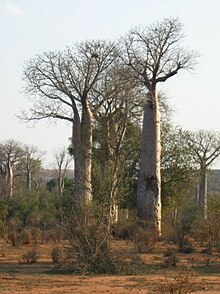Wool tree plants
| Wool tree plants | ||||||||||||
|---|---|---|---|---|---|---|---|---|---|---|---|---|

Baobab tree ( Adansonia digitata ), blossom |
||||||||||||
| Systematics | ||||||||||||
|
||||||||||||
| Scientific name | ||||||||||||
| Bombacoideae | ||||||||||||
| Burnett |
The wool tree plants (Bombacoideae) are a subfamily in the family of the mallow plants (Malvaceae). The subfamily only includes 16 to 21 (previously around 30) genera with around 120 species. For example, the baobab tree or Baobab ( Adansonia digitata ), one of the most characteristic trees of the African landscape, belongs to this family.
description


Vegetative characteristics
They are trees that can reach heights of up to 70 meters. The alternate leaves are pinnate or finger-shaped.
Generative characteristics
The hermaphroditic flowers are radial symmetry and five-fold with a double flower envelope . The sepals are more or less strongly fused. The flowers contain many stamens .




Systematics
Individual genera and species previously placed here, for example the species of the tribe Durioneae, for example the durian ( Durio zibethinus ), are placed in the subfamily Helicteroideae and the species of the tribe Matisieae are placed in the Malvoideae .
The subfamily Bombacoideae contains about 21 genera:
- Tribus Adansonieae: It contains about 15 genera:
- Baobabs ( Adansonia L. ): It contains about nine species, found in Africa , Madagascar and Australia .
-
Aguiaria Ducke : it contains only one species:
- Aguiaria excelsa Ducke : It occurs in Brazil .
-
Bernoullia Oliv. : It contains only three types:
- Bernoullia flammea olive. : It occurs in the Neotropic .
- Bombacopsis Pittier : It contains about 20 species. Belongs to the genus Pachira .
- Bombax L. (Syn .: Salmalia Schott & Endl .): According to various sources, there are 8 to 60 species.
- Catostemma Benth. : The ten or so species are common in northern South America.
- Cavanillesia Ruiz & Pav .: The approximately five species are common in the Neotropic.
- Ceiba Mill. (Syn .: Campylanthera Schott & Endl. , Chorisia H.BK , Eriodendron DC. , Erione Schott & Endl. , Spirotheca Ulbr. ): The ten to 17 species are common in the Neotropic; one species is also found in West Africa.
- Eriotheca Schott & Endl. : The twelve species are common in the Neotropic.
-
Gyranthera Pittier : The only three species occur in Panama , Venezuela and Ecuador.
- Gyranthera caribensis Pittier : From Venezuela
- Huberodendron Ducke : The four or so species are common in the Neotropics.
-
Neobuchia Urb. : It contains only one type:
- Neobuchia paulinae Urb. : This endemic occurs only in Haiti .
- Pachira Aubl. : The 24 to 46 species are common in the Neotropics and Africa.
- Pseudobombax Dugand : The 15 to 20 kinds are common in the Neotropic.
-
Scleronema Benth. : The only five species occur in tropical South America.
- Scleronema micranthum (Ducke) Ducke : From northern Brazil, Colombia, Peru and Venezuela
- Spirotheca Ulbr. : The 5 to 9 species are common in the Neotropic.
- Tribus Ochromeae: It contains only two genera and five species:
-
Ochroma Sw. : It contains only one type:
- Balsa tree ( Ochroma pyramidale (Cav.) Urban , Syn .: Ochroma lagopus Sw. ): It occurs in the Neotropic.
-
Patinoa Cuatrec. : The four or so species occur in tropical South America.
- Patinoa almirajo Cuatrec. : From Colombia to Peru, Brazil and Panama.
-
Ochroma Sw. : It contains only one type:
- "Septotheceae":
-
Septotheca Ulbr. : It contains only one species (previously with five to eleven species):
- Septotheca tessmannii Ulbr. : It occurs in northern Brazil, Peru and Colombia.
-
Septotheca Ulbr. : It contains only one species (previously with five to eleven species):
- Tribus Fremontodendreae:
- × Chiranthofremontia (= Chiranthodendron × Fremontodendron ): It contains only one clan:
- × Chiranthofremontia lenzii Henrickson
-
Chiranthodendron Larreat. : It contains only one type:
- Chiranthodendron pentadactylon Larreat. : It occurs in Mexico and Guatemala .
-
Fremontodendron Coville : It contains only a few species, which some authors also consider to be subspecies of a single species, Fremontodendron californicum . For other authors it is the types:
- Fremontodendron californicum (Torr.) Coville : It occurs in California, Arizona and Baja California .
- Fremontodendron decumbens R.M.Lloyd (Syn .: Fremontodendron californicum (Torr.) Coville subsp. Decumbens (RMLloyd) Munz ): It occurs in California.
- Fremontodendron mexicanum Davidson : It occurs from California to the Mexican state of Baja Norte .
- × Chiranthofremontia (= Chiranthodendron × Fremontodendron ): It contains only one clan:
use
Some of the genera are also of great commercial interest because they provide wood , such as the balsa tree ( Ochroma pyramidale ).
Other tree species are used to obtain kapok , a plant fiber that is difficult to spin. These include the kapok tree ( Ceiba pentandra ) and the Asian kapok tree ( Bombax ceiba ) and some other species.
swell
- Family of the Malvaceae and there also the subfamily of the Bombacoideae on the AP website. (Sections Description and Systematics)
- David John Mabberley: Mabberley's Plant-Book. A portable dictionary of plants, their classification and uses. 3rd edition, Cambridge University Press 2008, ISBN 978-0-521-82071-4 .
Individual evidence
- ^ Systematics of the Malvaceae.
- ^ Walter M. Kelman: A revision of Fremontodendron (Sterculiaceae). In: Systematic Botany , Volume 16, Issue 1, 1991, pp. 3-20. JSTOR 2418969
- ↑ a b c Bombacoideae in the Germplasm Resources Information Network (GRIN), USDA , ARS , National Genetic Resources Program. National Germplasm Resources Laboratory, Beltsville, Maryland. Retrieved June 13, 2017.
- ↑ Susanne Bickel-Sandkötter: Useful plants and their ingredients. Quelle & Meyer Verlag, Wiebelsheim 2001, ISBN 3-494-02252-6 .